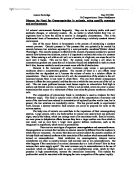Drawing on examples from the key concepts, discuss the extent to which animals and humans have an innate predisposition to learning.
Drawing on examples from the key concepts, discuss the extent to which animals and humans have an innate predisposition to learning.
Animals and humans both have an innate predisposition to learning. This is shown with animals like snakes who are not “reared” by their parents but still know how to hunt. However some behaviours must be learned, this is the cognitive view. The biological view believes there is prepared, unprepared and contraprepared learning. All this will be explained below.
Korad Lorenze who was an ethologist found that hatchlings, he work was with young geese; follow the first moving object they see after birth. He called this imprinting. Imprinting applies to animals, mainly birds but also humans. Lorenze conducted a famous experiment to prove that imprinting was permanent and it happened during a critical period. A critical period means that the learning must take place during a set time or not at all. For the experiment Lorenze took a clutch eggs before they were due to hatch , he left half with the goose mother and kept the other half with him. When they hatched he kept the ones who were separated from the mother with him and left the others with the goose mother. All the hatchlings were then put together in a box and allowed to mix, when they were removed from this box they separated to their respective guardians. Lorenze believed that the developments learned during the critical period were irreversible and long-lasting. The consequences are split up into short term and long term points. In the short term this bonding is necessary for food and safety and in the long term it produces a template for reproductive patterns. However there are problems with this concept. The idea of a critical period, has been critized as it is better described as a sensitive period. This is because learning can occur outside the time period. The assumption that imprinting is irreversible has been critzed as an experiment was done by Guiton proving that learned behaviors during the sensitive period are reversible. Imprinting can be applied to humans. Just as with animals, it has become clear that infants become attached to their mothers, and mothers to their infants, not so much through learning as by instinct. They are innately programmed to do so from birth; this is the most basic of many such direct expressions of the genetic heritage of our species.







